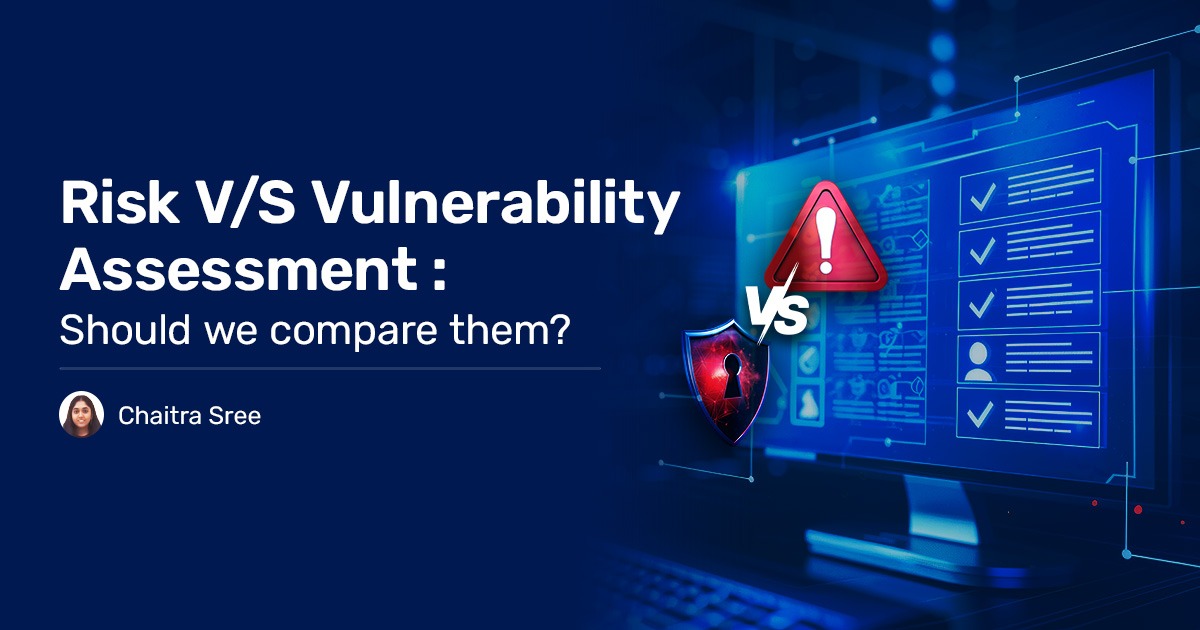With so much information/ data stored digitally or on the cloud, the risk it poses is unavoidable. Cyberattacks are rising, and attackers are getting sophisticated while planning an attack. The first step you take to overcome these attacks is to implement a strategy for risk reduction.
Should enterprises follow risk assessment or vulnerability assessment? Should you even think about choosing one?
It’s essential we learn the basics. In this blog, let’s delve deep into what risk and vulnerability assessment are and whether there is any difference between them.
What is Risk Assessment?
Risk assessment is a process of identifying weaknesses in your IT that will negatively impact the network. This process helps you understand the likelihood and consequences of various threats, which allows for informed decision-making regarding risk management strategies.
How does Risk Assessment Work?
The risk assessment process typically involves several key steps:
- Identification: Recognize potential risks or analyze risks that could compromise your IT network or affect your assets, operations, or objectives.
- Analysis: Evaluate the nature and potential impact of these risks. This includes assessing both the likelihood of occurrence and the severity of consequences.
- Evaluation: Compare the identified and analyzed risks against predetermined criteria to prioritize them based on their significance.
- Mitigation: Develop strategies to manage or mitigate the prioritized risks, which may include implementing controls or building strategy plans.
What is Vulnerability Assessment?
Usually, a vulnerability scanner goes through the IT network, looking for vulnerabilities in hardware, software assets, or even ports. This does not involve evaluating the likelihood of a vulnerability exploiting.
How does Vulnerability Assessment Work?
The vulnerability assessment process involves:
- Identification: Locate and document potential vulnerabilities within enterprise IT assets.
- Scanning: Use tools and techniques to detect vulnerabilities. This might usually involve running automated scanning software on a complete network.
- Analysis: Assess the potential impact of these vulnerabilities, including how they could be exploited by threats.
- Prioritization: Rank the vulnerabilities based on their severity and potential impact to address the most critical issues first.
- Remediation: Develop and implement plans to address and fix identified vulnerabilities.
Risk vs. Vulnerability
A risk is the potential or likelihood of vulnerability being exploited. On the other hand, vulnerability refers to a weakness or gap present in an IT network.
Why Shouldn’t we compare them?
Even though risk and vulnerability assessments look similar, they have their own sets of differentiation and limitations. Let’s take a quick look at them:
| Risk Assessment | Vulnerability Assessment |
| Broad, covering all potential risks | Focus merely on a few vulns |
| The main goal is to detect and respond to risks/threats | The main goal is to address the risks |
| Risks are evaluated based on their impact and likelihood | Risks are evaluated based on the tool implemented |
| It is usually done continuously | This is done on a periodic basis |
To answer the question of why we shouldn’t compare them. Enterprises implementing either risk or vulnerability assessment are not completely secure. To stay ahead of attacks, it is required to identify risks both internally and externally as well as by considering the likelihood and impact factors.
Tools like SanerNow combine risk vulnerability assessments. Investing in these tools will also reduce the cost of multiple tools.
Conclusion
Understanding the risk and vulnerability assessments is crucial for effective risk management. While risk assessment provides a broad view of potential threats and helps prioritize risks, vulnerability assessment offers details about specific weaknesses that need to be remediated.
By integrating both assessments, you can create a robust defense strategy that not only identifies and prioritizes risks but also ensures that vulnerabilities are effectively managed and remediated.


